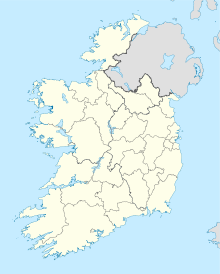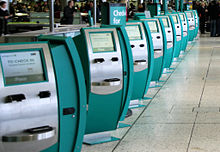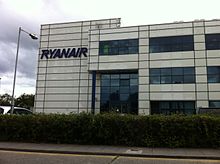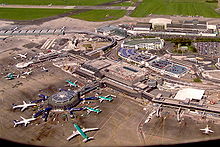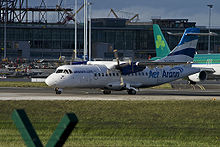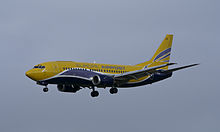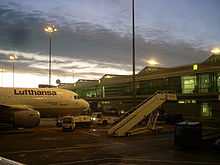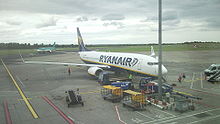- Dublin Airport
-
Dublin Airport
Aerfort Bhaile Átha Cliath
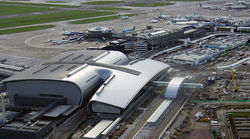
IATA: DUB – ICAO: EIDW Summary Airport type Public Owner Government of Ireland Operator Dublin Airport Authority Serves Dublin Location Fingal, County Dublin, Ireland Hub for - Aer Lingus
- Aer Lingus Regional
- CityJet
- Europe Airpost
- Ryanair
- Thomson Airways
Elevation AMSL 242 ft / 74 m Coordinates 53°25′17″N 006°16′12″W / 53.42139°N 6.27°WCoordinates: 53°25′17″N 006°16′12″W / 53.42139°N 6.27°W Website Map Location within Ireland Runways Direction Length Surface m ft 10/28 2,637 8,652 Concrete 16/34 2,072 6,798 Asphalt 11/29 1,339 4,393 Asphalt/concrete Statistics (2010) Passengers 18,431,265 Passenger change 09-10  10.1%
10.1%Aircraft movements 160,324 Movements change 09-10  9.3%
9.3%Source: Irish AIS[1]
Statistics[2]Dublin Airport, (Irish: Aerfort Bhaile Átha Cliath) (IATA: DUB, ICAO: EIDW), is operated by the Dublin Airport Authority. Located in Collinstown, in the Fingal part of County Dublin, 18.4 million passengers passed through the airport in 2010,[2] making it the busiest airport in the Republic of Ireland, followed by Cork and Shannon. It is the busiest on the island of Ireland followed by Belfast International, Belfast City, Cork and Shannon.
The airport is located 5.4 NM (10.0 km; 6.2 mi) [1] north of Dublin City in a once-rural area near Swords, and is served by buses and taxis. Metro North, a rapid transit line in development, will connect the airport to Swords and Dublin city centre.
Dublin Airport is the headquarters of Ireland's flag carrier Aer Lingus, Europe's largest no-frills airline Ryanair and Ireland's domestic, regional airline Aer Arann. Ireland's fourth airline, CityJet, operates flights from the airport and its HQ is located in the nearby town of Swords.
The airport has an extensive short and medium haul network, served by an array of carriers. Domestic services are offered to most regional Irish airports. There are approximately 40 daily departures from Dublin to all five London airports (Stansted, Luton, Gatwick, Heathrow and London City). There are over 30 daily departures to other UK Airports. There is also a reasonably sized long-haul network. Aer Lingus serves many popular US destinations, and has been able to add more thanks to the open skies deal. US legacy carriers also serve the airport from major US hubs. Etihad Airways operates a twice daily service between the airport and Abu Dhabi and from 9 January 2012 Emirates will begin a new daily direct service to Dubai.[3]
United States border preclearance services are available at the airport for US-bound passengers, Dublin being one of only two European airports with this facility, along with Shannon.
Contents
History
The beginnings in the 1930s and early 1940s
In 1936 the Government of Ireland established a new civil airline, Aer Lingus, which began operating from the military aerodrome, Casement Aerodrome, at Baldonnel to the south of Dublin. However, the decision was made that a civil airport should replace Baldonnel as the city's airport. Collinstown, to the north of Dublin, was selected as the location for the new civil aerodrome. Collinstown's first association with aviation was as a British military air base during World War I, but had been unused since 1922. Construction of the new airport began in 1937. By the end of 1939 a grass airfield surface, internal roads, car parks and electrical power and lighting were set up. The inaugural flight from Dublin took place on 19 January 1940 to Liverpool. In 1940 work began on a new airport terminal building. The terminal building design was by the architect Desmond FitzGerald, brother of politician Garret FitzGerald.[4] It opened in early 1941, with its design being heavily influenced by the bridges of the luxury ocean liners of the time. The terminal was also awarded the Triennial Gold Medal of the Royal Hibernian Institute of Architects and is today a listed building. Upon the outbreak of World War II, services were severely restricted at Dublin Airport until late 1945 and the only international scheduled route operated during this time was by Aer Lingus to Liverpool (and for a period to Manchester's Barton Aerodrome). Three new concrete runways were completed by 1947.
Expanding in the 1950s
Throughout the 1950s Dublin Airport expanded with virtually uninterrupted traffic growth. Runway extensions and terminal enhancements were carried out to deal with the influx of traffic and passengers. New airlines began serving the airport also. These included British European Airways, Sabena and BKS. In 1958 a new transatlantic service was started by Aer Lingus via Shannon Airport. During the 1960s the number of scheduled carriers continued to grow and aircraft continued to evolve with technological advancement. By the close of the 1960s, a sizeable number of Boeing 737s, BAC One-Elevens, Boeing 707s, and Hawker Siddeley Tridents were using Dublin Airport on a regular basis. During 1969, 1,737,151 passengers travelled through Dublin Airport.
The advent of wide-body aircraft posed opportunities and challenges for aviation. In 1971 Aer Lingus took delivery of two new Boeing 747 aircraft (a third Boeing 747 was delivered later that decade). To cope with this, a new passenger terminal capable of handling five million passengers per year was opened in 1972. The growth which was anticipated at the airport (and provided for through heavy investment by the airport and Aer Lingus) during the 1970s did not materialise immediately.
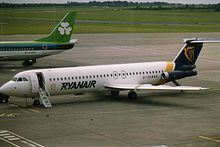 Two of the airport's largest operators side-by-side, a Ryanair BAC 1-11 and an Aer Lingus Boeing 737 in 1993.
Two of the airport's largest operators side-by-side, a Ryanair BAC 1-11 and an Aer Lingus Boeing 737 in 1993.
Continuing in the 1980s
In 1983 Aer Lingus opened its 'Aer Lingus Commuter' division which took delivery of Shorts, Saab, and Fokker turboprop aircraft to open regular daily domestic services to and from Ireland's smaller regional airports for the first time, as well as to serve existing routes to smaller regional airports in the United Kingdom. At various stages of its operations, flights were operated to several Irish regional airports to feed passengers into Aer Lingus's international network. These domestic destinations included Cork Airport, Shannon Airport, Kerry Airport, Galway Airport, Ireland West Airport Knock, Waterford Airport, Sligo Airport, and City of Derry Airport in Northern Ireland. Aer Lingus Commuter has since been re-absorbed into the main company. The domestic routes, with the exception of Dublin-Shannon, have been taken over by Aer Arann, including the route to Derry in Northern Ireland. Aer Lingus has continued with the remaining Dublin–UK flights.
During the 1980s, major competition, especially on the Dublin–London routes, resulted in passenger numbers swelling to 5.1 million in 1989. In the same year a new 8,650 ft (2,640 m) runway and a state-of-the-art air traffic control centre were opened. Dublin Airport continued to expand rapidly in the 1990s. Pier A, which had been the first extension to the old terminal building, was significantly extended. A new Pier C, complete with air bridges, was built and as soon as this was completed, work commenced to extend it to double its capacity. The ground floor of the original terminal building, which is today a listed building, was returned to passenger service after many years to provide additional departure gates. Pier D, completed in October 2007, is a dedicated low-fares boarding area and provides 14 quick turn-around stands and departure gates; these are not served by air bridges.
The Bilateral Air Transport Agreement
In 1993, a major milestone for the airport was the signing of a new United States – Republic of Ireland bilateral agreement which allowed airlines to operate some direct transatlantic services for the first time to/from Dublin Airport instead of touching down en route at Shannon Airport on the west coast of Ireland (Shannon had once been a major transatlantic refuelling stop for pre-jet aircraft, and this agreement was designed to protect the interests of the Shannon region when modern jets no longer required a refuelling stop and Shannon saw a fall-off in traffic). Airlines still had to provide an equal number of flights either to or through Shannon as to Dublin. A gradual further watering down of Shannon's so-called 'stopover' status came into effect in November 2006 when more direct flights to Dublin were allowed. The stopover requirement disappears completely in 2008. At that time, airlines will be allowed to fly direct to the US from Dublin without having to match these with any to/from Shannon. It is expected that this will result in a huge increase in services between Dublin and the US, and Aer Lingus has identified 16 destinations that it would like to serve direct from Dublin.
Recent history
With the success of Ireland's 'Celtic Tiger' economy, Dublin Airport has seen growth in the 1990s and 2000s. This demand has been driven by an increased demand for business travel to and from the country, together with an increase in inward tourism, and a surge in demand for foreign holidays and city breaks from the Irish, who are now one of the wealthiest populations in the world. In January 2006, the number of trips abroad taken by the Irish outnumbered the number of inbound trips for the first time since records began. Christmas shopping weekends in New York City have increased in popularity (although London is still the top destination from Dublin). A further source of demand has been for flights to holiday homes and investment properties which have been snapped up by the property-hungry Irish across southern European holiday hotspots, the emerging economies of Eastern Europe, and beyond.
Finally, the demand from Ireland's migrant workers, principally those from Eastern Europe, has resulted in a large number of new routes opening to destinations in the European Union accession states. Ireland was one of only three European Union countries (as well as the United Kingdom and Sweden) to open its borders freely to workers from the ten accession states that joined the European Union in 2004. This resulted in hundreds of thousands of people moving to Ireland from these countries since then.
The airport has seen significant declines in traffic in 2009 and 2010.
Long-haul traffic
The DAA (Dublin Airport Authority) has ambitious long-haul expansion plans and has successfully added new routes to North America and the Middle East in recent years. It has yet to secure a direct route to East Asia. Like most airports, the effects of the September 11, 2001 attacks affected transatlantic traffic but this has since recovered to record levels.
In 2005 Gulf Air launched a direct route to Bahrain in the Middle East. This was followed by Aer Lingus's service to Dubai in March 2006, and Etihad Airways service to Abu Dhabi in July 2007. Despite reportedly high loads, the Gulf Air service to Bahrain was cancelled in July 2007 as part of a broad restructuring plan of the airline. This move prompted Etihad Airways to bring forward the start date of its Abu Dhabi service by a number of months, and Etihad's Dublin route has proved to be a success with further frequencies planned. The DAA announced as far back as the late 1990s that it would like to add a route to East Asia, however this has yet to materialise and Aer Lingus's poorly performing route to Dubai was dropped at the end of March 2008.,[5] however the introduction of services to Asia remains part of Aer Lingus' long term plans. Etihad Airways are currently the only airline to offer a direct service to the Gulf area from Dublin, with onward connections to the Far East and Australia.
In February 2010, United Arab Emirates airline Etihad Airways announced an increase in services to Dublin from Abu Dhabi which means that from 28 March 2010 twice-daily flights will be available on Thursdays, Saturdays & Sundays with a once-daily service on Mondays, Tuesdays, Wednesdays and Fridays.[6]
In September 2010, US Airways announced that it will commence daily direct services from Dublin to Charlotte in North Carolina from May 2011. It will be a summer seasonal route running until September.[7]
In September 2011, Emirates announced that from 09 January 2012 it will begin a new daily direct service to Dubai, which will be year-round and will operate from the new Terminal 2.[8]
Open Skies and the Shannon Stopover
In the mid twentieth century, the Irish government introduced a rule stating that all air traffic between Ireland and the United States must transit through Shannon airport. In return, the United States government placed a limit of four airports in the U.S. that Aer Lingus could operate to. On 22 March 2007, the Open Skies agreement between the U.S. and EU was ratified. This resulted in the immediate cancellation of the long-running 'Shannon Stopover' requirement whereby the Irish government insisted that 50% of all transatlantic flights between Ireland and the United States must pass through Shannon Airport.
US border preclearance
Dublin Airport is one of only two airports outside of North America with United States border preclearance services for U.S.-bound passengers (the other being Shannon Airport). It allows passengers to have their paperwork dealt with before departure saving time upon arrival in the United States.
Aer Rianta and Dublin Airport Authority
In October 2004, Aer Rianta (which means 'Air Ways' or 'Air Tracks' in Irish) was renamed as the Dublin Airport Authority plc, following the State Airports Act 2004. All assets and liabilities previously owned by Aer Rianta were transferred to Dublin Airport Authority. The State Airports Act 2004 also established new airport authorities at Shannon and Cork Airports. The Shannon Airport Authority plc and the Cork Airport Authority have separate boards of directors and have been authorised under the Act to prepare business plans, which may in time lead to their full separation from the Dublin Airport Authority.
As the largest gateway to Ireland, over 21.1 million passengers travelled through the airport in 2006, a 2.7 million (or 15%) increase over 2005. The main contributors to the growth in traffic in 2005 were the airport's routes to continental Europe (particularly Poland and the Baltic region), North America, and the Middle East. Domestic and UK traffic had showed a small decline in 2005, but grew by 25% and 4% respectively in 2006. The decline in 2005 was due to a reduction in connecting traffic between Ireland's regional airports and the UK. This was as a result of a growing direct network of routes between those airports and the UK and continental Europe, dispensing with the need to transit at Dublin. But the organic demand at Dublin resulted in a net increase in those markets in 2006. Dublin Airport also welcomes over one million passengers per annum from across the border in Northern Ireland, whose largest airport is less than a quarter the size of Dublin in terms of passenger numbers.
Passenger terminals
Terminal 1
The current Terminal 1 building originally opened in 1972, and was initially designed to handle five million passengers per year. The original design included a second pier which would have been identical to the current decagon-shaped boarding pier B, but this was never built. A car park was originally located on the upper floor of the building, and the access ramps are still in place but it was closed for security reasons in the 1970s and converted into offices. Terminal 1 has been regularly extended and improved over the last two decades. In October 2007, a new pier designed by Skidmore, Owings and Merrill,[9] whom also designed graphics for its interior, was opened to the north of terminal 1.[10] This pier caters for the majority of Ryanair flights. In 2009, a new extension featuring new food and retail outlets was added to the side of Terminal 1. Terminal 1 is currently home to all short haul flights, except those of Aer Lingus.
Terminal 2
Terminal 2 is a 75,000 m2 (810,000 sq ft) terminal and pier (pier E) which provides 19 air bridges for aircraft and is capable of handling 15 million passengers annually, thereby allowing the airport to handle 35 million passengers a year. The project was designed by Pascal+Watson architects and the total cost is put at €600 million. Another pier (Pier F) is planned to be built to the south of Terminal 2 when required. The majority of long-haul carriers have moved to Terminal 2,[11] including Aer Lingus, which has relocated all its mainline operations, with the exception of flights operated by Aer Lingus Regional. Terminal 2 also features a new US pre-clearance immigration facility. Construction of Terminal 2 began on 1 October 2007, and was officially opened on November 19, 2010.[12] The project has been subject to significant criticism, as it has opened at a time when air traffic at Dublin airport has been subject to significant declines. Currently the following airlines are operating from Terminal 2 in Dublin Airport: Aer Lingus, American Airlines, Continental Airlines, Emirates, Etihad Airways, US Airways and Delta.[13]
Maintenance facilities
Aer Lingus, Ryanair, CityJet, Eirtech and Dublin Aerospace have aircraft maintenance hangars and facilities at Dublin Airport. In 2010 Etihad Airways announced a new maintenance hangar which will handle the Airbus A330-200 which the airline uses on their route from Dublin. In time the airline will allow other airlines to use this facility.[14]
Office facilities
The airport has the headquarters of Aer Lingus and Ryanair.[15][16] The Dublin Airport Authority has its head office on the grounds of the airport.[17]
Airport developments
Capacity
Due to the growth experienced at Dublin Airport in recent years, the facility became congested. One part or another of the airport has been a building site for the past two decades. Despite the building works and extensions, it is widely accepted by the DAA that Terminal 1 and its infrastructure were insufficient to deal with the volume of passengers. Both the Irish Government and the DAA have come under pressure from airlines and passengers alike to once-and-for-all provide a realistic increase in capacity for the future. As a result, the DAA plan to invest €2 billion in a 10-year capital development programme to effectively double the size of the passenger facilities of Dublin Airport.[18]
Criticism
The plans for Terminal 2 have been met with ongoing criticism from those who argued that, once built, it could not be extended to provide any additional capacity, owing to its location. A third terminal, which is in the blueprint for the future of the airport, would most likely be located between the parallel runways.[19]
The greatest objections continue to come from Ryanair.[20][21][22] The no-frills carrier has long lobbied for Terminal 2 to be built as a low-cost facility, and run by a competing operator. They have even offered to build and operate such a facility. However, the Irish government decided that the DAA would build T2 and that its operation would be put out to tender. In March 2010 it was decided that T2 would be operated by the DAA as the other applicants did not meet the requirements for operating the terminal.
New air traffic control complex
Planning is currently under way for a new air traffic control complex and control tower which will replace the existing structure. The new facility has been designed by Scott Tallon Walker architects. A planning application was submitted in August 2009.[23] The new control tower will be 86.9 m (285 ft) in height. The new control tower is necessary because the construction of the future parallel runway will obstruct visibility of certain parts of the airport from the existing control tower.[24]
New runway
 Main Apron seen from the air Pier C (centre, now replaced by Terminal 2) clearly visible with Cargo ramp and Ryanair Maintenance facilities.
Main Apron seen from the air Pier C (centre, now replaced by Terminal 2) clearly visible with Cargo ramp and Ryanair Maintenance facilities.
A new runway measuring 3,110 m (10,203 ft) is planned to be built parallel to the existing runway 10/28, which opened in 1989. Detailed proposals and planning permission were submitted to Fingal County Council (under whose jurisdiction Dublin Airport lies) and approved in April 2006. An appeal to An Bord Pleanála (The Irish Planning Appeals Board), which determines appeals and other cases under the national planning acts, was heard in September 2006, and this resulted in the granting of permission in August 2007, with 31 planning conditions attached.
The new runway will replace runway 11/29 (which is no longer in use as a runway, and is used for aircraft parking) and will be built 1,690 m (5,545 ft) to the north of and parallel to the existing runway 10/28. The new runway will allow the airport to accommodate 30 million passengers per annum once in operation, and will be 3,110 m (10,203 ft) long.[25] In March 2009 the DAA announced in a proposal for consultation that the new runway may be built to a length of 3,660 m (12,008 ft) following consultation with potential long-haul carriers. A runway of this length would allow direct flights from Dublin to the Far East.[26]
In the meantime, the Authority has invested heavily in extending aprons and creating rapid exit taxiways to derive maximum efficiency from the existing main runway. Runway 11/29, the shortest and one of the oldest runways, is closed to allow overspill aircraft parking. This runway will disappear under the new parallel runway in due course.
However, in December 2008, the Dublin Airport Authority announced that it would postpone the construction of the new parallel runway by three to four years, on account of the need to cut costs and predictions of falling consumer demand for air travel. This is a result of the recent global financial crisis. [27]
Airlines and destinations
Note: † - Charter airlines and their destinations
Airlines Destinations Terminal Adria Airways Seasonal: Ljubljana 1 Aer Arann Isle of Man, Kerry
Chartered: Manchester1 Air Europa † Seasonal: Palma de Mallorca [begins 29 May 2012] 1 Aer Lingus Alicante, Amsterdam, Barcelona, Berlin-Schönefeld, Birmingham, Boston, Brussels, Bucharest-Henri Coandă, Budapest, Chicago-O'Hare, Düsseldorf, Edinburgh, Faro, Frankfurt, Fuerteventura, Geneva, Gran Canaria, Hamburg, Kraków, Lanzarote, Lisbon, London-Gatwick, London-Heathrow, Lyon, Madrid, Málaga, Manchester, Milan-Linate, Milan-Malpensa Munich, Nice, New York-JFK, Orlando, Paris-Charles de Gaulle, Prague, Rome-Fiumicino, Stuttgart, Tenerife-South, Toulouse, Vienna, Vilnius, Warsaw, Zürich
Seasonal: Agadir, Athens, Bilbao, Bologna, Bordeaux, Burgas, Catania, Dubrovnik, Helsinki, Ibiza, İzmir, Jersey, Marseille, Naples, Palma de Mallorca, Perpignan, Santiago de Compostela, Venice-Marco Polo
Seasonal charter: Salzburg [begins 24 December]2 Aer Lingus Regional
operated by Aer ArannAberdeen, Blackpool, Bristol, Cardiff, Edinburgh, Glasgow-International
Seasonal: Rennes1 Air Canada Seasonal: Toronto-Pearson 1 Air France
operated by CityJetLondon-City, Paris-Charles de Gaulle
Seasonal: Pau1 Air Italy † Seasonal: Milan-Malpensa 1 AMC Airlines † Seasonal: Sharm el-Sheikh [begins 22 December] 1 Air Transat Seasonal: Montréal-Trudeau, Toronto-Pearson 1 American Airlines Seasonal: Chicago-O'Hare 2 Arkia Israel Airlines Seasonal: Tel Aviv-Ben Gurion 1 BH Air † Seasonal: Bourgas 1 Blue Air Bacău, Bucharest-Băneasa 1 BMI London-Heathrow 1 BMI operated by BMI Regional London-Heathrow 1 Bulgaria Air † Seasonal: Plovdiv [begins 7 January] 1 Cimber Sterling Seasonal: Billund 1 CityJet † Manchester 1 Continental Airlines Newark, Washington-Dulles [begins 8 June 2012][30] 2 Delta Air Lines Atlanta, New York-JFK 2 Emirates Dubai [begins 9 January][31] 2 Etihad Airways Abu Dhabi 2 Europe Airpost † Salzburg
Seasonal: Burgas, Dalaman [begins 11 June 2012], Dubrovnik, Edinburgh, Faro, Gran Canaria, Heraklion, Lanzarote, La Rochelle, Lisbon, Málaga, Naples, Palma de Mallorca, Plovdiv [begins 24 December], Toulouse [begins 26 December], Verona, Zakynthos1 Flybe Exeter, Southampton
Chartered seasonal: Salzburg [begins 24 December], Verona1 Flybe operated by Loganair Donegal 1 Germania † Seasonal: Faro [begins 20 May 2012], Malaga [begins 19 May 2012], Menorca [begins 19 May 2012] 1 Germanwings Seasonal: Cologne/Bonn 1 Holidays Czech Airlines Seasonal: Prague
Chartered seasonal: Heraklion, Palma de Mallorca, Reus, Zakynthos1 Iberia operated by Air Nostrum Madrid 1 Jet2.com † Seasonal: Chambéry 1 Jet4You† Agadir [resumes 19 May 2012] 1 Lufthansa Frankfurt
Seasonal: Munich1 Lufthansa Regional operated by Contact Air Seasonal: Düsseldorf [begins 9 May 2012] 1 Lufthansa Regional operated by Eurowings Seasonal: Düsseldorf [begins 6 May 2012] 1 Malév Hungarian Airlines Budapest 1 Norwegian Air Shuttle Copenhagen, Oslo-Gardermoen 1 Onur Air † Seasonal: Antalya, Bodrum, İzmir 1 Orbest Orizonia Airlines Lanzarote
Seasonal: Faro [begins 20 May], Gran Canaria [begins 5 May 2012], Ibiza [begins 18 May 2012], Palma de Mallorca, Reus [begins 25 May]1 Pegasus Airlines † Seasonal: Bodrum, İzmir 1 Ryanair Alghero, Alicante, Barcelona, Berlin-Schönefeld, Birmingham, Bologna, Bratislava, Bristol, Brussels-South Charleroi, Bydgoszcz, Carcassonne, East Midlands, Edinburgh, Eindhoven, Faro, Frankfurt-Hahn, Fuerteventura, Gdańsk, Girona, Glasgow-Prestwick, Gran Canaria, Grenoble, Katowice, Kaunas, Kraków, Lanzarote, Leeds/Bradford, Liverpool, Łódź, London-Gatwick, London-Luton, London-Stansted, Madrid, Málaga, Malta, Manchester, Memmingen, Milan-Bergamo, Murcia, Nantes, Newcastle upon Tyne, Oslo-Rygge, Paris-Beauvais, Pisa, Poznań, Riga, Rome-Ciampino, Rzeszow, Stockholm-Skavsta, Szczecin, Tallinn, Tenerife-South, Vilnius, Wrocław
Seasonal: Biarritz, Ibiza, La Rochelle, Marseille, Nice, Palma de Mallorca, Porto, Reus, Rodez, Salzburg, Santander, Seville, Tours, Trapani, Turin, Valencia, Venice-Treviso, Zadar1 SATA International Funchal 1 Scandinavian Airlines Copenhagen, Oslo-Gardermoen, Stockholm-Arlanda 1 Sky Airlines † Seasonal: Bodrum 1 Spanair † Seasonal: Reus 1 Strategic Airlines † Seasonal: Laranca [begins 16 June 2012] 1 Swiss International Air Lines Zürich 1 S7 Airlines Seasonal: Moscow-Domodedovo 1 Tailwind Airlines † Seasonal: İzmir 1 Thomson Airways Gran Canaria, Lanzarote
Seasonal: Burgas, Corfu, Faro [begins 31 May 2012], Innsbruck, Larnaca, Málaga, Palma de Mallorca, Sharm el-Sheikh, Turin1 Travel Service † Lanzarote 1 Tunisair † Enfidha 1 Turkish Airlines Istanbul-Atatürk 1 US Airways Philadelphia
Seasonal: Charlotte2 Cargo
Airlines Destinations Air France Cargo Chicago-O'Hare, Paris-Charles de Gaulle DHL Express East Midlands, London-Luton FedEx Express Paris-Charles de Gaulle FedEx Feeder Birmingham, East Midlands, Glasgow-International, London-Stansted, Manchester, Shannon TNT Airways Birmingham, Liège, Shannon UPS Airlines Cologne/Bonn, Shannon Statistics
Passenger numbers
Passenger numbers at Dublin Airport increased every year during the 10 years between 1998 and 2008, by an average of 10.2% per annum from around 11.6 million to over 23.4 million. Passenger numbers fell however during the subsequent two years to around 18.4 million in 2010.[2]
Year Passengers Passengers
Change
YoY %1998 11,641,100 - 1999 12,802,031  10.0
10.02000 13,843,528  8.1
8.12001 14,333,555  3.5
3.52002 15,084,667  5.2
5.22003 15,856,084  5.1
5.12004 17,138,373  8.1
8.12005 18,450,439  7.7
7.72006 21,196,382  14.9
14.92007 23,287,438  9.9
9.92008 23,466,711  0.8
0.82009 20,503,677  12.6
12.62010 18,431,265  10.1
10.1Sources:
1998-2001 - Aer Rianta[32]
2002-2005 - DAA[33]
2006-2009 - DAA[34]
2010 - Anna.aero[2] See also: Busiest airports in the Republic of Ireland by total passenger traffic
See also: Busiest airports in the Republic of Ireland by total passenger trafficBusiest routes
20 busiest international routes at Dublin Airport (2010) Rank Airport Passengers Handled 1  London Heathrow
London Heathrow1,491,297 2  London Gatwick
London Gatwick842,777 3  London Stansted
London Stansted719,536 4  Paris-Charles de Gaulle
Paris-Charles de Gaulle585,231 5  Manchester
Manchester553,921 6  Birmingham
Birmingham538,702 7  New York JFK
New York JFK476,044 8  Malaga
Malaga454,058 9  Amsterdam
Amsterdam439,482 10  Frankfurt
Frankfurt430,414 11  Edinburgh
Edinburgh376,642 12  Madrid
Madrid332,877 13  Faro
Faro311,890 14  Liverpool
Liverpool286,181 15  London Luton
London Luton272,582 16  Bristol
Bristol268,605 17  Chicago O'Hare
Chicago O'Hare257,944 18  Berlin Schönefeld
Berlin Schönefeld220,495 19  Lanzarote
Lanzarote203,748 20  Barcelona
Barcelona202,943 Source: Central Statistics Office (Ireland) [35] Ground transport
Dublin Airport is located just off the M1 and the M50 10 km (6.2 mi)[1] north from the city centre and 2 km (1.2 mi) south of the town of Swords.
Until the Metro North[36] rail link to Dublin city centre is completed (see below), the public transport options to the city are taxis, buses, and private transport. Passengers can however connect by bus or taxi to Dublin's railway stations.
Dublin Airport Parking
More than 22,000 public parking spaces. Largest car park in Ireland managed through a sophisticated online prebooking system linked to ANPR and a DESIGNA Abacus Car Park system.
19,300 Long term Parking spaces - Express Red LT Car Park 8,400 spaces. Next to the Airport, High frequency ( 5-8 min) shuttle bus provided by Firstgroup the parent company of Aircoach. Transfer Time 5 min. This car park is noted for it’s large population of Hares!
- Holiday Blue LT Car Park 8,600 spaces. Parallel to the main runway to the north of the airport. Shuttle bus frequency 10-15 min, Transfer time 10min.
- Overflow Green LT Car Park. Only used in peak season.
2,900 short term parking spaces. All next to the Terminal. Av 5 min walk to check-in. - Terminal 1 Car Parks .o Short Term A. Best for T1 pickup and drop off (450 spaces)
o Short Term C. Best for stays of 1-7days (1445 spaces)
o Collinstown Car Park. PRM ( Blue Badge) parking (55 Spaces)
- Terminal 2 Car Park (Built 2010)
o Single car park for Pick –up and dropoff and stays of 1-7days (950 Spaces)
o PRM ( Blue Badge) parking (42 Spaces)
o Electric car charging (5 spaces)
Bus
Dublin Airport is served by a large network of bus and coach routes, serving both the wider Dublin area and intercity links to the rest of Ireland.
Dublin area
Dublin Bus is the main provider of transport to and from Dublin Airport operating Airlink Express routes 747 and 748 which serve Busáras (Dublin's central bus station for intercity and regional bus services), Dublin Connolly railway station and Dublin Heuston railway station along with the city centre.
In addition to the limited stop Airlink services, Dublin Bus runs a number of local stopping services that serve Dublin Airport from such areas as Santry, Swords, Rathfarnham, Sutton. Beaumont. Harold's Cross. Drumcondra and Portmarnock.
Aircoach offers a number of coach services from the Airport to the Dublin area, serving both the city centre and surrounding areas including Ballsbridge, Leopardstown, Dalkey, Greystones. Blackrock, Dun Laoghaire, Ballinteer, Dundrum, Churchtown, Terenure and Templeogue amongst others.
Urbus provides a service from Swords, Tyrrelstown, Castleknock and Blanchardstown whilst Flybus operates a service from Tallaght and Clondalkin.
Intercity services
National bus and coach operator Bus Éireann offers a large number of routes from Dublin Airport to all around Ireland including key destinations such as Belfast, Galway, Wexford. Sligo, Donegal, Drogheda, Navan and Wicklow.
A number of private operators also run intercity services with Aircoach offering a service to Cork, Citylink and Gobus offer services to Galway whilst JJ Kavanagh operate regular services to Limerick, Kilkenny and Waterford.
Car rental
Car rental at Dublin Airport is serviced by all major car rental brands including Sixt, Thrifty, Europcar and Hertz in both Terminal 1 and Terminal 2. In Terminal 1, all car rental desks are located in the main arrivals hall and are immediately visible upon exiting customs. In Terminal 2, after exiting customs follow the signs for the car rental desks which will be found by walking straight ahead.
Rail
Iarnród Éireann (Irish Rail) provide suburban and intercity railway services from Dublin Connolly and Dublin Heuston railway stations. There are direct regular bus services to both stations from the airport. Some city bus services serve Drumcondra suburban railway station, which is on the Connolly to Maynooth railway line. Bus services to Busáras/Dublin Connolly and Dublin Heuston railway stations connect with the Luas Red Line.
Plans for rail link
For many years, it was expected that Iarnród Éireann, the state railway company, would extend the Dublin Area Rapid Transit (DART) with a spur off the Dublin to Belfast line that would serve the airport and Swords. These plans were replaced with plans for an underground metro line, which would run from the city centre to Swords via the airport. The route for the line, Metro North, was announced on 19 October 2006 and is designed to connect with several other modes of transport.[36]
There will be three stops in Dublin's city centre, allowing transfers to both Luas lines, and the proposed DART Underground. Another transfer will be possible at Drumcondra. Beyond the airport, Metro North will continue to Swords, where many airport workers live. There will be a number of park and ride stops along the route.[37] Journey time between the airport and St Stephen's Green will be 18 minutes.
Dublin Airport City
The Dublin Airport Authority has recently announced plans for an ambitious development of the Dublin Airport area and surrounding environs. This ambitious project will develop a 350-acre (1.4 km2) land reserve situated to the east of Dublin Airport and will cost in the region of €4 billion. Of this 350 acres (1.4 km2), 90% is already owned by the Dublin Airport Authority, and they are confident that they will be able to purchase the remaining pockets. The development will be mainly high rise, and will be expected to be completed by 2028. There will be 600,000 m2 (6,500,000 sq ft) of office space along with 40,000 m2 (430,000 sq ft) of retail, hotel and conference facilities. It is expected that the journey time from office to airport will be in the region of 6 minutes.[38]
References
- ^ a b c EIDW – Dublin/International (PDF). AIP and charts from the Irish Aviation Authority.
- ^ a b c d Anna.aero - European Airport Traffic Trends
- ^ http://dublinairport.com/gns/at-the-airport/latest-news/11-09-08/Dublin_Airport_Welcomes_New_Emirates_Service_To_Dubai.aspx New Dubai route
- ^ Desmond Fitzgerald on Archiseek
- ^ "Aer Lingus timetable". Aerlingus.com. http://www.aerlingus.com/cgi-bin/obel01im1/Services/timetable.jsp. Retrieved 2011-02-03.
- ^ "Etihad Airways builds on Dublin success". Etihadairways.com. http://www.etihadairways.com/sites/Etihad/ie/en/aboutetihad/mediacenter/newslisting/newsdetails/Pages/EtihadAirwaysbuildsonDublinsuccess.aspx?fromNewsListing=true. Retrieved 2011-02-03.
- ^ "US Airways to begin direct flights from Dublin to Charlotte". Irishtimes.com. 2010-09-20. http://www.irishtimes.com/newspaper/finance/2010/0920/1224279263698.html. Retrieved 2011-02-03.
- ^ http://dublinairport.com/gns/at-the-airport/latest-news/11-09-08/Dublin_Airport_Welcomes_New_Emirates_Service_To_Dubai.aspx New Dubai route
- ^ "Pier D To Open On Sunday". Build.ie, Ireland's Construction Directory. October 26, 2007. http://www.build.ie/construction_news.asp?newsid=67680.
- ^ "Dublin Airport - Pier D Environmental Graphics". SOM.com. http://staging-www.som.com/content.cfm/dublin_airport_pier_d_environmental_graphics.
- ^ "New Terminal to Transform Dublin Airport". Dublinairport.com. http://www.dublinairport.com/about-us/media-centre/press-releases/T2_DAA.html. Retrieved 2011-02-03.[dead link]
- ^ "Opening date for Terminal 2 set - RTÉ News". Rte.ie. 2010-10-21. http://www.rte.ie/news/2010/1021/daa-business.html. Retrieved 2011-02-03.
- ^ "Airlines Flying From Dublin Airport T2". Dublin Airport T2. http://www.dublinairportt2.com/airlines.php. Retrieved 2011-07-20.
- ^ Hancock, Ciarán. "One more thing." Irish Times. Friday 18 June 2010. Retrieved on 13 July 2010.
- ^ "compreg.pdf." Ryanair. Retrieved on 25 May 2009.
- ^ "About Us." Aer Lingus. Retrieved on 7 July 2010.
- ^ "Contact Us." Dublin Airport Authority. Retrieved on 7 July 2010.
- ^ Stephen Jio. "Transforming Dublin Airport". Dublinairportauthority.com. http://www.dublinairportauthority.com/TDA/Overview/. Retrieved 2011-02-03.
- ^ http://www.fdb.ie/Michael_OLeary.pdf
- ^ "Ryanair Criticises Lack of Consultation With Airline Customers by DAA on Terminal 2". Ryanair.com. 2005-09-20. http://www.ryanair.com/site/EN/news.php?yr=05&month=sep&story=gen-en-200905-3. Retrieved 2011-02-03.
- ^ "Regulator Rewards Incompetence of the DAA 22% Price Increase for People to Enter or Leave the "Rip Off Republic"". Ryanair.com. http://www.ryanair.com/site/EN/news.php?yr=05&month=sep&story=gen-en-290905. Retrieved 2011-02-03.
- ^ "Minister Cullen Breaks His Own Terminal 2 Promises and Safeguards". Ryanair.com. http://www.ryanair.com/site/EN/news.php?yr=05&month=sep&story=gen-en-300905. Retrieved 2011-02-03.
- ^ http://www.iaadublincontroltower.ie
- ^ Neil Callanan (2008-07-13). "New control tower needed at Dublin airport as it 'can not see end of new runway'". Tribune.ie. http://www.tribune.ie/archive/article/2008/jul/13/new-control-tower-needed-at-dublin-airport-as-it-c/. Retrieved 2011-02-03.
- ^ "Parallel Runway". Dublinairport.com. http://www.dublinairport.com/about-us/airport-development/Parallel_Runway.html. Retrieved 2011-02-03.
- ^ "DAA PROPOSED CAPITAL INVESTMENT PROGRAMME 2010 - 2014". Aviationreg.ie. http://www.aviationreg.ie/DAA_proposed_Capital_Investment_Programme_2010__2014/Default.383.html. Retrieved 2011-02-03.
- ^ "Plan to cut airport jobs and shelve Dublin's second runway". Irishtimes.com. 2008-12-12. http://www.irishtimes.com/newspaper/frontpage/2008/1218/1229523051614.html. Retrieved 2011-02-03.
- ^ "Map of Scheduled Destinations . Retrieved 2009-10-27". Dublinairport.com. http://www.dublinairport.com/flight-information/destinations-and-airlines/. Retrieved 2011-02-03.
- ^ Stephen Jio. "Official list of charter airlines at Dublin Airport . Retrieved 2009-08-30". Dublinairportauthority.com. http://www.dublinairportauthority.com/doing-business/advertising/dublin-airport/scheduled-flights.html. Retrieved 2011-02-03.
- ^ http://ir.unitedcontinentalholdings.com/phoenix.zhtml?c=83680&p=irol-newsArticle&ID=1627749&highlight=
- ^ http://www.emirates.com/ae/english/about/news/news_detail.aspx?article=711393&offset=0
- ^ Aer Rianta Regional Analysis of Passenger Movements
- ^ Dublin Airport Authority plc Annual Report and Accounts 2005
- ^ Dublin Airport Authority plc Annual Report and Financial Statements 2009
- ^ CSO Ireland Database - Air Passenger Movement
- ^ a b Metro North[dead link]
- ^ "Metro North - Selected Route Map". Rpa.ie. 2011-01-20. http://www.rpa.ie/?id=315. Retrieved 2011-02-03.
- ^ "Dublin Airport City". Infoireland.wordpress.com. 2008-06-07. http://infoireland.wordpress.com/2008/06/27/dublin-airport-city. Retrieved 2011-02-03.
External links
Transport in Dublin Air Rail Tram*Road Bus corridorsR101 · R102 · R103 · R104 · R105 · R106 · R107 · R108 · R109 · R110 · R111 · R112 · R113 · R114 · R115 · R116 · R117 · R118 · R119 · R120 · R121 · R122 · R123 · R124 · R125 · R126 · R127 · R128 · R129 · R130 · R131 · R132 · R133 · R134 · R135 · R136 · R148 · R156 · R403 · R445 · R761 · R810 · R817 · R821 · R822 · R824 · R825 · R826OtherWater CanalsPortsAgencies *=Tram systems no longer run. Information in parentheses shows the operator(s)Airports in Ireland Northern Ireland 
Republic of Ireland Smaller font-size indicates airports handling domestic, charter or private services only.Categories:- Airports in the Republic of Ireland
- Airports with United States border preclearance
- Buildings and structures in Fingal
- Proposed airport expansion
- Transport in County Dublin
- Airports established in 1940
Wikimedia Foundation. 2010.

